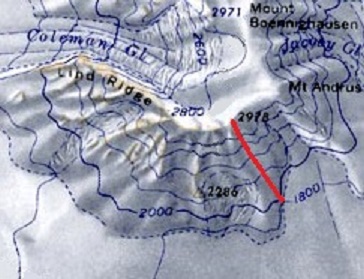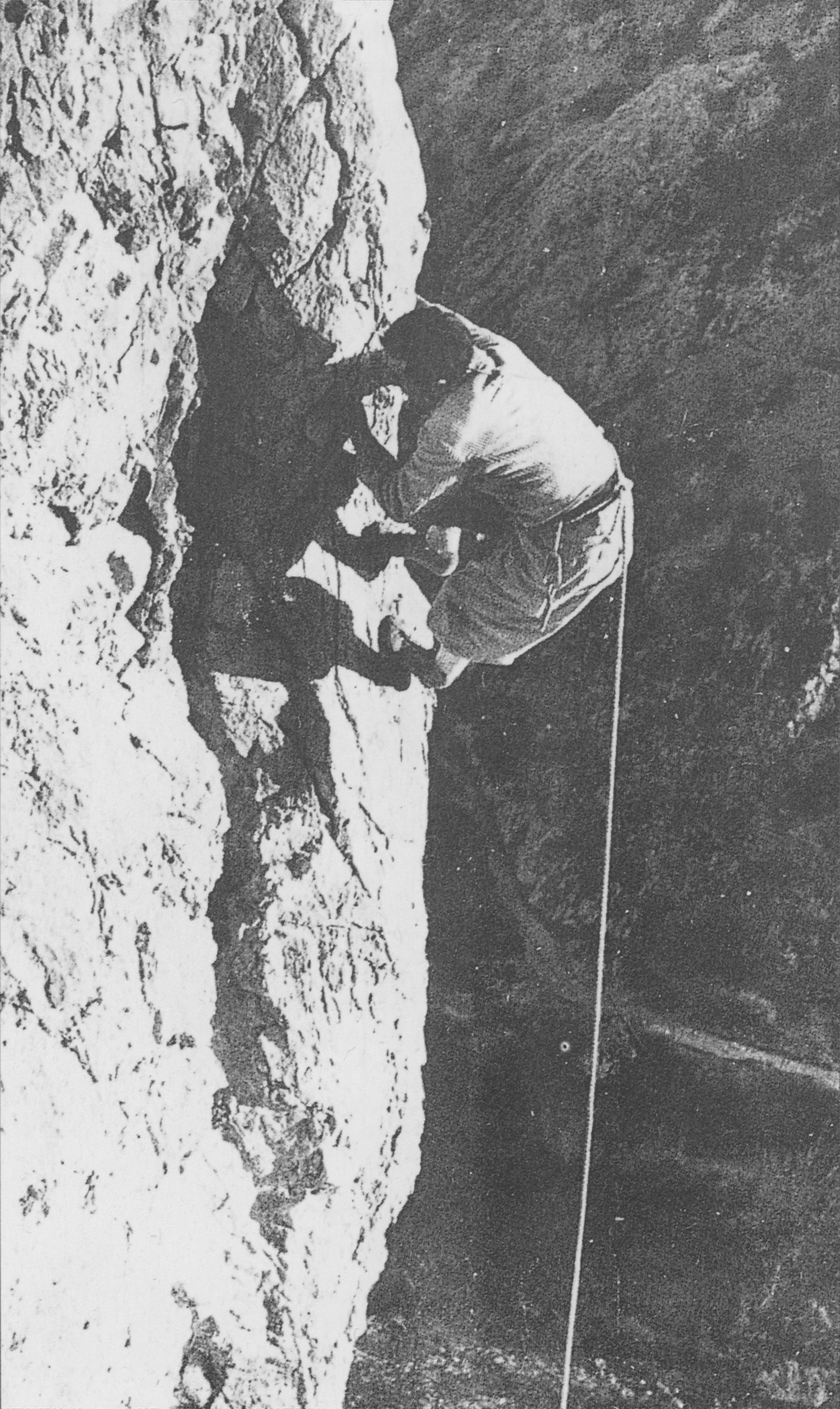|
Direttissima (climbing)
A ''direttissima'' (Italian for "shortest link") is a climbing term meaning a direct climb to the summit of a mountain up the fall line from the valley base to the top. Whilst the normal route aims to find the way with the least difficulty, the climber attempting a ''direttissima'' faces the challenge of ascending the mountain in a more "direct" way. Definition The term stems from Italian climber, Emilio Comici, who said: "I wish some day to make a route, and from the summit let fall a drop of water, and this is where my route will have gone" There are usually many climbing routes to the summit of a mountain and it often takes days of studying to work out which route might be suitable. Sometimes the theoretical considerations turn out to be impracticable or inexpedient in hindsight. But the alpinist who decides to climb a mountain peak or rock face ''direttissima'' may only depart slightly from the vertical line to the summit during his ascent. History Reinhold Messner wrote th ... [...More Info...] [...Related Items...] OR: [Wikipedia] [Google] [Baidu] |
Climbing
Climbing is the activity of using one's hands, feet, or any other part of the body to ascend a steep topographical object that can range from the world's tallest mountains (e.g. the eight thousanders), to small boulders. Climbing is done for locomotion, sporting recreation, and for competition, and is also done in trades that rely on ascension; such as emergency rescue and military operations. Climbing is done indoors and outdoors and on natural (e.g. rock and ice) and artificial surfaces. Professional mountain guides or rock climbing guides (e.g. the UIAGM), were a significant element in developing the popularity of the sport in the natural environment, and remain so today. Since the 1980s, the development of competition climbing and the availability of artificial climbing walls have dramatically increased the popularity of rock climbing as a sport and led to the emergence of professional rock climbers, such as Wolfgang Güllich, Chris Sharma, Lynn Hill and Catherine ... [...More Info...] [...Related Items...] OR: [Wikipedia] [Google] [Baidu] |
Fall Line (topography)
A fall line refers to the line down a mountain or hill which is most directly downhill; that is, the direction a ball or other body would accelerate if it were free to move on the slope under gravity. Mathematically the fall line, the line of greatest slope, is the negative of the gradient (which points uphill) and perpendicular to the contour lines. In mountain biking, a trail follows the "fall line" if it generally descends in the most downward direction, rather than traversing in a sideways direction. A skier is said to be "skiing the fall line" if they are moving generally down, making turns either side of the fall line, rather than moving across the slope. See also * Glossary of cycling * Ridge line * Topography * Topographic profile A topographic profile or topographic cut is a representation of the relief of the terrain that is obtained by cutting transversely the lines of a topographic map. Each contour line can be defined as a closed line joining relief points at eq ... [...More Info...] [...Related Items...] OR: [Wikipedia] [Google] [Baidu] |
Normal Route
A normal route or normal way (french: voie normale; german: Normalweg) is the most frequently used route for ascending and descending a mountain peak. It is usually the simplest route. Overview In the Alps, routes are classed in the following ways, based on their waymarking, construction and upkeep: * Footpaths (''Fußwege'') *Hiking trails (''Wanderwege'') * Mountain trails (''Bergwege'') * Alpine routes (''Alpine Routen'') *Climbing routes (''Kletterrouten'') and High Alpine routes (''Hochalpine Routen'') in combined rock and ice terrain, (UIAA) graded by difficulty Sometimes the normal route is not the easiest ascent to the summit, but just the one that is most used. There may be technically easier variations. This is especially the case on the Watzmannfrau, the Hochkalter and also Mount Everest. There may be many reasons these easier options are less well-used: * the simplest route is less well known than the normal route (Watzmannfrau). * the technically easiest route is mor ... [...More Info...] [...Related Items...] OR: [Wikipedia] [Google] [Baidu] |
Emilio Comici
Leonardo Emilio Comici (21 February 1901 – 19 October 1940) was an Italian mountain climber and caver. He made numerous ascents in the Eastern Alps, particularly in the Dolomites (where he made over 200 first ascents during his career) and in the Julian Alps. Comici was nicknamed the "Angel of the Dolomites". In the 1930s and 1940s Comici and other climbers (including Riccardo Cassin, Raffaele Carlesso and Alvise Andrich) represented the Italian answer to the achievements of German climbers. Comici perfected the Bavarian technique of mountain climbing, and began the era of "sixth grade" climbing (at that time the highest climbing grade considered humanly surmountable). He was the inventor and proponent of using multi-step aid ladders, solid belays, the use of a trail/tag line, and hanging bivouacs, contributing greatly to the techniques of big wall climbing. Biography Emilio Comici was the son of Antonio Comici and Regina Cartago. A longshoreman in his youth, he began mou ... [...More Info...] [...Related Items...] OR: [Wikipedia] [Google] [Baidu] |
Climbing Route
A climbing route is a path by which a climber reaches the top of a mountain, rock, or ice wall. Routes can vary dramatically in difficulty and grade; once committed to that ascent, it can sometimes be difficult to stop or return. Choice of route can be critically important. Guidebooks, if available, are helpful in providing detailed diagrams and photographs of routes. In the earliest days of hillwalking and mountaineering, climbers got to the top by whatever means got them there. Little information about how they did it is available. During the 19th century, as explorers of the Alps tried ever harder summits, it became clear that choosing an eastern face over a southwestern ridge could spell the difference between success or failure. One example was the first ascent of the Matterhorn, which had been repeatedly and unsuccessfully attempted via the southern side. The strata there tended to slope down and away while the rocks of the northeastern ridge (the one closest to Ze ... [...More Info...] [...Related Items...] OR: [Wikipedia] [Google] [Baidu] |
Reinhold Messner
Reinhold Andreas Messner (; born 17 September 1944) is an Italian mountaineer, explorer, and author from South Tyrol. He made the first solo ascent of Mount Everest and, along with Peter Habeler, the first ascent of Everest without supplemental oxygen. He was the first climber to ascend all fourteen peaks over above sea level without oxygen. Messner was the first to cross Antarctica and Greenland with neither snowmobiles nor dog sleds. He also crossed the Gobi Desert alone. He is widely considered one of the greatest mountaineers of all time. From 1999 to 2004, Messner served as a member of the European Parliament for north-east Italy, as a member of the Federation of the Greens. Messner has published more than 80 books about his experiences as a climber and explorer. In 2018, he received jointly with Krzysztof Wielicki the Princess of Asturias Award in the category of Sports. Early life and education Messner was born within a German-speaking family settled in St. Peter, ... [...More Info...] [...Related Items...] OR: [Wikipedia] [Google] [Baidu] |
Redpoint (climbing)
In rock climbing, redpointing means to free-climb a route while lead climbing, but only after having practiced the route beforehand (either by hangdogging or top roping), or after having fallen or rested on the rope, on the first attempt. Climbers will try to redpoint a route after having failed to on-sight it (free climb the route on the first attempt with no falls and no prior information), or flash it (free climb the route on the first attempt with no falls but with prior information). Redpointing is sometimes narrowly defined as climbing a route after a failed first attempt (regardless of how long ago, or how many failures occurred). Description Climbers can rest during a redpoint ascent, but not using the rope or any artificial aids (e.g. they can hang off the holds, or use a kneebar). Where the climber falls on a redpoint ascent, they must return to the very bottom, pull their rope free of the route, and completely re-start the ascent from scratch. Redpointing differs ... [...More Info...] [...Related Items...] OR: [Wikipedia] [Google] [Baidu] |
On-sight Climbing
__NOTOC__ This glossary of climbing terms is a list of definitions of terms and jargon related to rock climbing and mountaineering. The specific terms used can vary considerably between different English-speaking countries; many of the phrases described here are particular to the United States and the United Kingdom. A B Completing the climb upon one's first attempt ever. Often confused with 'flashing' which is the first attempt of the day. There is a second opportunity for a climber to 'blitz' a wall after 12 months. C D E ... [...More Info...] [...Related Items...] OR: [Wikipedia] [Google] [Baidu] |
Flash (rock Climbing)
__NOTOC__ This glossary of climbing terms is a list of definitions of terms and jargon related to rock climbing Rock climbing is a sport in which participants climb up, across, or down natural rock formations. The goal is to reach the summit of a formation or the endpoint of a usually pre-defined route without falling. Rock climbing is a physically and ... and mountaineering. The specific terms used can vary considerably between different English-speaking countries; many of the phrases described here are particular to the United States and the United Kingdom. A B Completing the climb upon one's first attempt ever. Often confused with 'flashing' which is the first attempt of the day. There is a second opportunity for a climber to 'blitz' a wall after 12 months. C ... [...More Info...] [...Related Items...] OR: [Wikipedia] [Google] [Baidu] |
Mount Everest
Mount Everest (; Tibetan: ''Chomolungma'' ; ) is Earth's highest mountain above sea level, located in the Mahalangur Himal sub-range of the Himalayas. The China–Nepal border runs across its summit point. Its elevation (snow height) of was most recently established in 2020 by the Chinese and Nepali authorities. Mount Everest attracts many climbers, including highly experienced mountaineers. There are two main climbing routes, one approaching the summit from the southeast in Nepal (known as the "standard route") and the other from the north in Tibet. While not posing substantial technical climbing challenges on the standard route, Everest presents dangers such as altitude sickness, weather, and wind, as well as hazards from avalanches and the Khumbu Icefall. , over 300 people have died on Everest, many of whose bodies remain on the mountain. The first recorded efforts to reach Everest's summit were made by British mountaineers. As Nepal did not allow foreigners ... [...More Info...] [...Related Items...] OR: [Wikipedia] [Google] [Baidu] |
Mountaineering
Mountaineering or alpinism, is a set of outdoor activities that involves ascending tall mountains. Mountaineering-related activities include traditional outdoor climbing, skiing, and traversing via ferratas. Indoor climbing, sport climbing, and bouldering are also considered variants of mountaineering by some. Unlike most sports, mountaineering lacks widely applied formal rules, regulations, and governance; mountaineers adhere to a large variety of techniques and philosophies when climbing mountains. Numerous local alpine clubs support mountaineers by hosting resources and social activities. A federation of alpine clubs, the International Climbing and Mountaineering Federation (UIAA), is the International Olympic Committee-recognized world organization for mountaineering and climbing. The consequences of mountaineering on the natural environment can be seen in terms of individual components of the environment (land relief, soil, vegetation, fauna, and landscape) and location/z ... [...More Info...] [...Related Items...] OR: [Wikipedia] [Google] [Baidu] |









